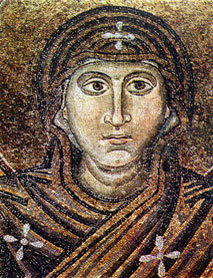| Go On Master Page | ||
| THE ST. SOPHIA CATHEDRAL | ||
| The St.
Sophia Cathedral Museum is a state-preserved architectural and historical monument located
in the centre of Kiev. This remarkably beautiful ensemble, representing 11th- to
18th-century architecture, occupies five hectares (12 1/3 acres) of spacious ''grounds.
Its focus point is the grandly soaring St. Sophia Cathedral, world-famed relic of
11th-century architecture and monumental art. The cathedral belongs to the most prosperous period of Kievan Rus, the mighty Eastern-Slavic state which was the cradle for three fraternal peoples – the Russians, Ukrainians and Byelorussians. Kievan Rus reached the acme in its economic and cultural development during the reign of Grand Prince Vladimir Svyatoslavich (978 – 1015) and his son, Prince Yaroslav the Wise (1019 – 1054). In 988 A. D. Grand Prince Vladimir Svyatoslavich introduced Christianity into Rus, and this was of great import to the future development of feudal relationships, to the consolidation of a united Rus, to the promotion of a cultural upsurge and to the widening of political and cultural ties with Byzantium and other European states. At the same time the new religion was a powerful means of consolidat'ng the feudal power. |
 Îðàíòà. Ôðàãìåíò. Ãîëîâíèé â³âòàð. |
|
| When Old Rus adopted Christianity, the building of brick churches began. The
best builders and artists of the time were called upon to take part, and these made use of
the highest art and technical achievements of the epoch. The murals and stone carvings
that ornamented the churches turned the latter into unique works of art. |
||
| The major task of town construction was solved simultaneously with the
building of brick churches. When the first brick church went up in the centre of Kiev –
the Church of the Tithes (989 – 996 A. D.) – Grand Prince Vladimir Svyatoslavich made
considerable extensions and fortifications to the town proper. |
||
| His son, Prince Yaroslav the Wise, continued his father's traditions: the
territory of the kremlin, or the main fortification, was increased eight-fold and
surrounded by new defence ramparts. |
||
| It was at this time that the main metropolitan church was built – St.
Sophia Cathedral, the principal monumental structure of the kremlin. According to
chronicles the foundation of the cathedral was laid in 1017 or 1037. |
||
| St. Sophia Cathedral, the central structure of Yaroslav's town, was
surrounded by brick churches, boyars' castles, and dwellings of the townsmen. The grounds
of the city were guarded by a brick wall. In our days, the only relics of the 11th century
that have survived, are the St. Sophia Cathedral and the ruins of the Golden Gate – the
main entrance into ancient Kiev. |
||
| The name of the cathedral, 'Sophia,' comes from the Greek word 'sophia' which
means 'wisdom.' Consecrated to the 'wisdom of Christ's teaching,' the cathedral would,
according to its founder Yaroslav, firmly establish Christianity and the rule of the
feudal princes in Rus. |
||
| As the main metropolitan church of Rus, St. Sophia Cathedral in those early times was the community and cultural centre of the state. It was here that the coronation ceremony was performed to anoint and crown the prince mounting the Grand Throne of Kiev; it was here that foreign ambassadors were received; here the Kiev veche (popular assembly) was held, before the cathedral walls; here the chronicles were written, for Yaroslav the Wise established at St. Sophia the first library and scriptorium in Old Rus, the first so far as we know. As early as the 11th century, St. Sophia Cathedral was appraised as an outstanding masterpiece of art. Hillarion, the first Russian metropolitan and an eminent publicist of his time, wrote, "A church of wonder and glory, the envy of all the countries round, for such another cannot be found in the whole world from east to west." | ||
| St. Sophia's walls are ornamented with 11th-century mosaics and frescos, which are unique as far as the artistic merits of the ensemble are concerned. | ||
| Still preserved are 260 sq. m of mosaics and about 3000 sq. m of frescos. | ||
M O S A I C S |
||
| Mosaics decorate the chancel and the central cupola. These images represent the main personages in the Christian religion and are arranged strictly according to 'religious hierarchy' and correspond to the hierarchy of feudal society. | ||
| All the mosaics that survive are genuine relics of the 11th century. However,
some mosaics having missing parts were filled in with oil painting in the 19th century... |
||
| On the concha is the gigantic mosaic of the Virgin Orans, the madonna in
prayer. It dominates all the murals within the cathedral's interior, and is about
six metres high. The Virgin stands with raised hands on a broad platform ornamented with
precious stones. Mary wears a dark blue robe and a crimson mantle whose
folds are edged with gold... |
||
| Her shoes are red. A startling white fringed kerchief is draped over the red girdle round her waist. This mosaic of the Virgin Orans is full of grandeur, of unique monumental form and rich colouring. | ||
| Go On Master Page | ||